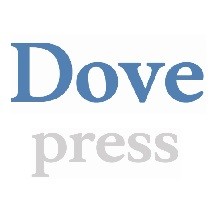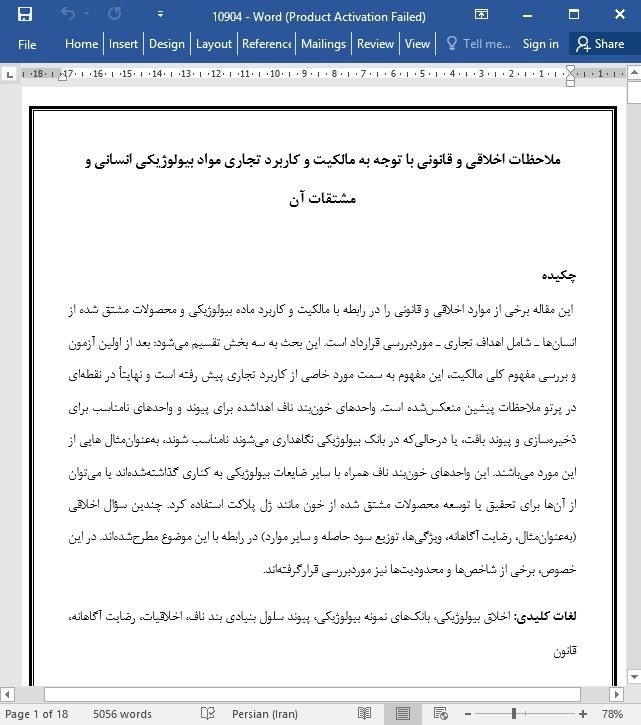
ملاحظات اخلاقی و قانونی با توجه به مالکیت و کاربرد تجاری مواد بیولوژیکی انسانی و مشتقات آن
چکیده
این مقاله برخی از موارد اخلاقی و قانونی را در رابطه با مالکیت و کاربرد ماده بیولوژیکی و محصولات مشتق شده از انسانها ـ شامل اهداف تجاری ـ موردبررسی قرارداد است. این بحث به سه بخش تقسیم میشود: بعد از اولین آزمون و بررسی مفهوم کلی مالکیت، این مفهوم به سمت مورد خاصی از کاربرد تجاری پیش رفته است و نهایتاً در نقطهای در پرتو ملاحظات پیشین منعکسشده است. واحدهای خونبند ناف اهداشده برای پیوند و واحدهای نامناسب برای ذخیرهسازی و پیوند بافت، یا درحالیکه در بانک بیولوژیکی نگاهداری میشوند نامناسب شوند، بهعنوانمثال هایی از این مورد میباشند. این واحدهای خونبند ناف همراه با سایر ضایعات بیولوژیکی به کناری گذاشتهشدهاند یا میتوان از آنها برای تحقیق یا توسعه محصولات مشتق شده از خون مانند ژل پلاکت استفاده کرد. چندین سؤال اخلاقی (بهعنوانمثال، رضایت آگاهانه، ویژگیها، توزیع سود حاصله و سایر موارد) در رابطه با این موضوع مطرحشدهاند. در این خصوص، برخی از شاخصها و محدودیتها نیز موردبررسی قرارگرفتهاند.
مقدمه
مدیریت ماده بیولوژیکی (سلولها و بافتها) نیازمند ملاحظاتی میباشند که عبارتند از ملاحظات تکنیکی ـ علمی، سازمانی، اخلاقی و قانونی.
نمونههای بیولوژیکی برای اهداف متفاوتی جمعآوری و ذخیره میشوند: تشخیص یا درمان فردی که خون وی جمعآوریشده است (بهعنوانمثال درمان کلینیکی)، اهدای شخصی برای اهداف درمانی (بهعنوانمثال، اهدای خون) و اهدا برای اهداف تحقیقاتی. مرزهای بین اهداف ممکن مشخص نبوده و همانطور که در زیر نیز تشریح شده است، محیطهای در حال تغییر ممکن است منجر به این رویداد شود که نمونههای جمعآوری و ذخیرهشده برای یک هدف جهت هدف دیگر بهکاربرده شوند.
شاخصهای پیشنهادی برای هر مورد
با ارجاع به سند معتبر دیگری، بررسی پاراگراف 2.08 نظامنامه اخلاق پزشکی که توسط انجمن پزشکان آمریکا (شورای امور اخلاقی و قضایی) منتشرشده بود، این موضوع بیانشده است:
1. رضایت اعلانشده بایستی از بیماران برای استفاده از ارگانها یا بافتها در تحقیقات کلینیکی کسب شود.
2. کاربردهای تجاری بالقوه بایستی برای بیمار پیش از اینکه سود موردنظر از محصولات توسعهیافته از مواد بیولوژیکی محقق، افشا شود.
3. بافت انسانی و محصولات آن ممکن است برای اهداف تجاری بدون رضایت کتبی بیماری که ماده سلولی از وی فراهمشده است، به کار نرود.
Abstract
This article considers some of the ethical and legal issues relating to the ownership and use – including for commercial purposes – of biological material and products derived from humans. The discussion is divided into three parts: after first examining the general notion of ownership, it moves to the particular case of possible commercial use, and finally reflects on the case in point in the light of the preceding considerations. Units of cord blood donated altruistically for transplantation and which are found unsuitable for storage and transplantation, or which become unsuitable while stored in biobanks, are taken as an example. These cord-blood units can be discarded together with other biological waste, or they can be used for research or the development of blood-derived products such as platelet gel. Several ethical questions (eg, informed consent, property, distribution of profits, and others) arise from these circumstances. In this regard, some criteria and limits to use are proposed.
Introduction
The management of biological material (cells and tissues) requires a number of considerations, including technical–scientific, organizational, ethical, and legal.1
Biological samples are collected and stored for widely differing purposes:2,3 diagnosis or treatment of the person from whom they are collected (eg, clinical treatment), altruistic donation for therapeutic purposes (eg, blood donation), and donation for purposes of research. The boundaries between purposes may blur, as will be explained below; changing circumstances may lead to samples collected and stored for one purpose being subsequently used for others.4
Proposed criteria for the case in point
With reference to yet another authoritative document, it may be helpful to examine paragraph 2.08 (“Commercial use of human tissue”) of the Code of Medical Ethics published by the American Medical Association (Council on Ethical and Judicial Affairs) already referred to,59 which states:
Physicians contemplating the commercial use of human tissue should abide by the following guidelines:
1. Informed consent must be obtained from patients for the use of organs or tissues in clinical research.
2. Potential commercial applications must be disclosed to the patient before a profit is realized on products developed from biological materials.
3. Human tissue and its products may not be used for commercial purposes without the informed consent of the patient who provided the original cellular material.
چکیده
مقدمه
مالکیت بدن و اعضای آن
کاربرد احتمالی تجاری
جوانب کلی
سه مثال مهم
دعوی مور علیه دانشگاه کالیفرنیا
دعوی گرین برگ علیه انستیتو تحقیقات بیمارستان کودکان میامی (MCH)
دانشگاه واشنگتن در برابر کاتالونا
نیاز به دستورالعملها
شاخصهای پیشنهادی برای هر مورد
Abstract
Introduction
Ownership of the body and its parts
Possible commercial use
General aspects
Three significant examples
Moore v the University of California
Greenberg v Miami Children’s Hospital (MCH)
The need for guidelines
Proposed criteria for the case in point
- اصل مقاله انگلیسی با فرمت ورد (word) با قابلیت ویرایش
- ترجمه فارسی مقاله با فرمت ورد (word) با قابلیت ویرایش، بدون آرم سایت ای ترجمه
- ترجمه فارسی مقاله با فرمت pdf، بدون آرم سایت ای ترجمه


